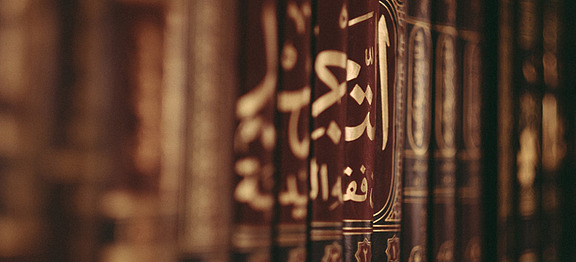
New Books by Faculty and Members
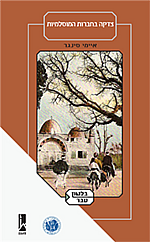
צדקה בחברות המוסלמיות Hebrew translation of Charity in Islamic Societies by Amy Singer (Cambridge University Press, 2008). Muslim beliefs have inspired charitable giving for over fourteen centuries, yet Islamic history has rarely been examined from this perspective. In Charity in Islamic Societies, Amy Singer explains the basic concepts and institutions of Muslim charity: the obligatory annual payment of zakat together with voluntary donations of all sizes, undertaken at every level of society, and across the span of individual lifetimes. Charitable endowments – established by rulers, wealthy individuals, and even those of more modest means – shaped Muslim societies, cultures, and landscapes in ever era. This book demonstrates how historical circumstances, social status, gender, age, and other factors interacted with religious ideals to produce a vast array of charitable practices, from the early days of Islam to the present. Relying on evidence from written texts, buildings, images, and objects to anchor the discussions in each chapter, the author explores the motivations for charity, its impact on the rich and the poor, and the politicization of giving, arguing that the study of philanthropy affords a unique prism through which to examine the past. Additional information.

Imāmī Thought in Iran during the Ilkhanid Period: The Ḥimṣī Rāzī Family, by Hassan Ansari and Sabine Schmidtke in collaboration with Hamid Ataei Nazari. Scholars studying the development of Imāmī thought are confronted with a lack of sources. Many pertinent works by Imāmī thinkers who lived in the various centers of Shīʿī learning between the lifetimes of al-Murtaḍā (d. 1044) and Naṣīr al-Dīn al-Ṭūsī (d. 1274) have not come down to us. Muʿtazilite thought, Avicennan notions, and the quest to return to the early doctrines of the imams constituted the principal parameters of Imāmī theological thought over those centuries. The present study, focusing on the Ḥimṣī Rāzī family, which flourished in Iran during the thirteenth and fourteenth centuries, showcases what can be achieved by gathering and piecing together relevant paratextual material that is preserved in manuscripts, providing insights into the scholarly profiles of its members. It is complemented by an editio princips of Mishkāt al-yaqīn, and a facsimile edition of the Talkhīṣ al-maqāṣid. Additional information.
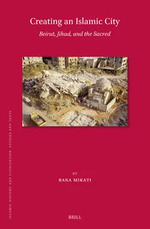
Creating an Islamic City: Beirut, Jihad, and the Sacred by Rana Mikati. In Creating an Islamic City: Beirut, Jihad, and the Sacred, Rana Mikati examines for the first time the role and contribution of Beirut to the Umayyad and early Abbasid caliphates. This book traces the transformation of Beirut from a Byzantine metropolis to a place of ribāṭ, weaving previously unpublished archaeological material and narrative sources. By examining Beirut’s transformation into a frontier town, the rise of a scholarly community around the Syrian jurist al-Awzā‘ī (d. 157/773-774), and its integration in an Islamic sacred landscape, Creating an Islamic City shows how a provincial frontier town was integrated and participated in the early caliphate. Additional information.

Literary Snippets: A Colophon Reader, edited by George Anton Kiraz and Sabine Schmidtke. This companion volume to Literary Snippets: Colophons Across Space and Time (Gorgias Press, 2023) gives examples of colophons from the Ancient Near East up to the pre-modern world, from different traditions – Akkadian, Hebrew, Arabic, Syriac, and Persian. Colophons typically provide their readers with the historical context in which the scribe produced his or her work: Who was the scribe? When and where was the manuscript produced? For whom was it produced and who paid for it? But colophons are far more rich. They are literary works in their own right, having a style and rhetoric independent of the main literary text of the manuscript. Some are assertive, providing contextual data about the scribe/publisher and manuscript/book; others are expressive, demonstrating the scribe's feelings and wishes. Some are directive, asking the reader for an action; others declarative, providing all sorts of statements about the scribe/publisher or even the reader. The latter sometimes provide historical facts otherwise lost to history: wars, earthquakes, religious events, and legal agreements. Through the colophons and translations in this volume we hope to present the colophon as a literary genre, and as literature to be studied, read and enjoyed. Additional information.
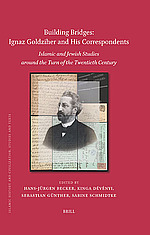
Building Bridges, Ignaz Goldziher and His Correspondents, Islamic and Jewish Studies around the Turn of the Twentieth Century, edited by Hans-Jürgen Becker, Kinga Dévényi, Sebastian Günther, and Sabine Schmidtke. The scholarship of Ignaz Goldziher (1850–1921), one of the founders of Islamic studies in Europe, has not ceased to be in the focus of interest since his death. This volume addresses aspects of Goldziher’s intellectual trajectory together with the history of Islamic and Jewish studies as reflected in the letters exchanged between Goldziher and his peers from various countries that are preserved in the Library of the Hungarian Academy of Sciences and elsewhere. The fourteen contributions deal with hitherto unexplored aspects of the correspondence addressing issues that are crucial to our understanding of the formative period of these disciplines. Additional information.

Religious and Intellectual Diversity in the Islamicate World and Beyond, Essays in Honor of Sarah Stroumsa (Volumes I and II), edited by Omer Michaelis and Sabine Schmidtke. Religious and Intellectual Diversity in the Islamicate World and Beyond is a collection of essays in honor of Sarah Stroumsa, an eminent scholar who through the years has embodied and advanced the possibility of collaboration across borders. The volume is presented to her by scholars working on the study of the intellectual history of the Middle Ages, the intercultural contact and migration of knowledge in the Islamic world, and many other topics. Additional information Volume I and Volume II.
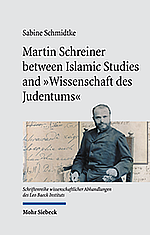
Martin Schreiner between Islamic Studies and »Wissenschaft des Judentums«. Reconstructing His Scholarly Biography by Sabine Schmidtke. In 1906 Martin Schreiner, who had been diagnosed with mental illness four years previously, wrote from the Sanatorium Berolinum in Berlin-Lankwitz to the librarian of the »Lehranstalt für die Wissenschaft des Judentums« in Berlin, asking to send him some books, in the hope of being released soon. This letter and some short letters dating from 1920 and 1922 constitute Schreiner's last written testimonies. His mental illness painfully and suddenly ended the short but productive career of a versatile scholar who was one of the most important exponents of the »Wissenschaft des Judentums« and who simultaneously engaged in the study of Islam. Schmidtke reconstructs his scholarly biography from his student days in Budapest to his active period in Berlin. The author focuses on his pioneering scholarship particularly in the field of Islamic intellectual history, where his main contributions dealt with the Muʿtazila, Ibn Taymiyya and his circle, the mystical tradition of Ibn ʿArabī, and interreligious polemics. Additional information.

Rulers as Authors in the Islamic World: Knowledge, Authority and Legitimacy. Volume Editors: Maribel Fierro, Sonja Brentjes, and Tilman Seidensticker. How widespread was authorship among rulers in the premodern Islamic world? The writings of different types of rulers in different regions and periods are analyzed in this book, from the early centuries in the central lands of Islam to 19th century Sudan. The composition of poetry appears as the most fertile area for authorship among rulers. Prose writings show a wide variety, from astrology to bookmaking, from autobiography to creeds. Some of the rulers made claims to special knowledge, but in all cases authorship played a special role in the construction of the rulers' authority and legitimacy. Additional information.
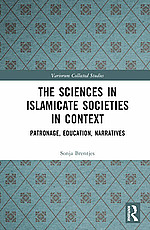
The Sciences in Islamicate Societies in Context Patronage, Education, Narratives by Sonja Brentjes. This Variorum volume reprints ten papers on contextual elements of the so-called ancient sciences in Islamicate societies between the thirteenth and the seventeenth centuries. They address four major themes: the ancient sciences in educational institutions; courtly patronage of science; the role of the astral and other sciences in the Mamluk sultanate; and narratives about knowledge. The main arguments are directed against the then dominant historiographical claims about the exclusion of the ancient sciences from the madrasa and cognate educational institutes, the suppression of philosophy and other ancient sciences in Damascus after 1229, the limited role of the new experts for timekeeping in the educational and professional exercise of this science, and the marginal impact of astrology under Mamluk rule. Additional information.
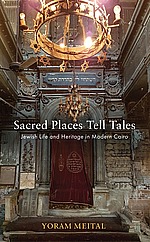
Sacred Places Tell Tales: Jewish Life and Heritage in Modern Cairo by Yoram Meital. Sacred Places Tell Tales narrates not only the past but also the unprecedented transformations that have occurred in recent years in Egypt. Through a first-of-its-kind study, this book views Cairo synagogues as exquisite storytellers. The synagogues still standing in Cairo shed new light on the social, cultural, and political processes that Egyptian society and the Jews had undergone since the last quarter of the nineteenth century. While only a handful of Jews live in Egypt, the preservation of Jewish heritage, first and foremost synagogues and cemeteries, enjoy a growing interest in public discourse and popular culture. The assortment of opinions raised regarding this turn indicates that the possible “reinstatement” of the Jewish past into Egyptian history is, in fact, a fierce debate about Egyptian society, its characteristics, and its identity, past and present. Additional information.

Caliphate and Imamate: An Anthology of Medieval Muslim Texts on Political Theology, edited by Hassan Ansari and Nebil Husayn. One of the most enduring sources of conflict among Muslims is the question of power and authority after the Prophet Muhammad. This anthology of classical Arabic texts, presented in a new English translation, offers a comprehensive overview of the early history of the caliphate and key questions that medieval Muslim scholars discussed in their works on the subject. Composed between the eleventh and thirteenth centuries, these texts succinctly present competing views on the prerequisites of legitimate leadership and authority in the Islamic tradition. This volume offers an engaging introduction to the diverse writings of influential scholars representing six classical Islamic schools of theology: Sunnism, Zaydism, Twelver Shiʿism, Muʿtazilism, Ibadism, and Ismaʿilism. Additional information.
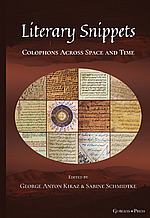
Literary Snippets: Colophons Across Space and Time, edited by George Anton Kiraz and Sabine Schmidtke. As we enter late antiquity, colophons take on a life of their own and begin to acquire literary properties—snippets but nevertheless literary objects. They developed into an art form with distinctive formulaic phraseology. In some traditions, scribes began to record historical events that occurred just before or during the production of a manuscript, events that otherwise would be lost to history. Readers and users also began to insert colophons in existing manuscripts, creating a plethora of colophon types. How are we to approach the study of colophons and what can they tell us about communities at large, or about individual scribes? And what of the colophon itself as an object? This edited volume brings together scholars from various disciplines to study colophons in various languages and traditions across space and time. Whatever you would like to get out of colophons, we hope that there will be at least one paper here that will draw your attention. If not, there are enough literary snippets quoted to keep you entertained. Additional information.

Historiography of the History of Science in Islamicate Societies: Practices, Concepts, Questions, by Sonja Brentjes. This book presents eight papers about important historiographical issues as debated in the history of science in Islamicate societies, the history of science and philosophy of medieval Latin Europe and the history of mathematics as an academic discipline. Six papers deal with themes about the sciences in Islamicate societies from the ninth to the seventeenth centuries, among them novelty, context and decline. Two other papers discuss the historiographical practices of historians of mathematics and other disciplines in the nineteenth and twentieth centuries. The central argument of the collected papers is that in addition and beyond the study of scientific texts and instruments historians of science in Islamicate societies need to pay attention to cultural, material and social aspects that shaped the scientific activities of the authors and makers of such texts and instruments. It is pointed out that the diachronic, de-contextualized comparison between methods and results of scholars from different centuries, regions and cultures often leads to serious distortions of the historical record and is responsible for the long-term neglect of scholarly activities after the so-called "Golden Age". Additional information.
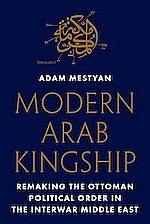
Modern Arab Kingship: Remaking the Ottoman Political Order in the Interwar Middle East, by Adam Mestyan. In this groundbreaking book, Adam Mestyan argues that post-Ottoman Arab political orders were not, as many historians believe, products of European colonialism but of the process of “recycling empire.” Drawing on previously unused Ottoman, French, Syrian, and Saudi archival sources, Mestyan explores ideas and practices of creating composite polities in the interwar Middle East and, in doing so, sheds light on local agency in the making of the forgotten Kingdom of the Hijaz, Jordan, Egypt, Saudi Arabia, and Syria, the first Muslim republic. Mestyan considers the adjustment of imperial Islam to a world without a Muslim empire, discussing the post-Ottoman Egyptian monarchy and the intertwined making of Saudi Arabia and the State of Syria in the 1920s and 1930s. Mestyan’s innovative analysis shows how an empire-based theory of the modern political order can help refine our understanding of political dynamics throughout the twentieth century and down to the turbulent present day. Additional information.
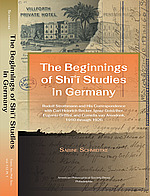
The Beginnings of Shī ʿī Studies in Germany: Rudolf Strothmann and His Correspondence with Carl Heinrich Becker, Ignaz Goldziher, Eugenio Griffini, and Cornelis van Arendonk, 1910 through 1926, by Sabine Schmidtke. Rudolf Strothmann (b. 1877, d. 1960) played a pioneering role in the scholarly exploration of Shī ʿī Islam in Western, especially German, scholarship. Between 1910 and 1923, he published many pathbreaking studies on the Zaydiyya, consulting primarily the recently purchased collections of Yemeni Zaydī manuscripts in Berlin. At the same time, and to the extent that this was possible in view of the lack of relevant sources in Germany and the rest of Europe, Strothmann began to delve into Twelver Shī ʿī literature, an endeavor that culminated in his 1926 monograph, Die Zwölfer-Schī ʿa: Zwei religionsgeschichtliche Charakterbilder aus der Mongolenzeit, a portrait of the two prominent seventh- and thirteenth-century Imāmī scholars Naṣīr al-Dīn al-Ṭūsī (d. 672/1274) and Raḍī al-Dīn ʿAlī b. Mūsā Ibn Ṭāwūs (d. 664/1266). Later in his life, Strothmann primarily focused on various strands of Ismāʿīlism. His rich published work testifies to his erudition and versatility and continues to form an important point of departure for scholars working on different aspects of Shī ʿism in the early twenty-first century. In addition, Strothmann’s use of the manuscript treasures in the Berlin State Library between 1908 and 1926 reflects his evolution as a scholar over those years. This study examines the earlier decades of Strothmann’s life and his development as a theologian and a scholar of Semitic languages and Islamic culture. Moreover, it sheds light on his scholarly work during the 1910s through his correspondence with Carl Heinrich Becker, Ignaz Goldziher, Eugenio Griffini, and Cornelis van Arendonk, of which an annotated edition is provided. Additional information.
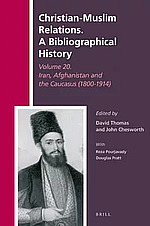
Christian-Muslim Relations, a Bibliographical History 20 (CMR 20), covering Iran, Afghanistan, Armenia, Azerbaijan and Georgia in the period 1800-1914, is a further volume in a general history of relations between the two faiths from the 7th century to the early 20th century. It comprises a series of introductory essays and the main body of detailed entries. These treat all the works, surviving or lost, that have been recorded. They provide biographical details of the authors, descriptions and assessments of the works themselves, and complete accounts of manuscripts, editions, translations and studies. The result of collaboration between numerous new and leading scholars, CMR 20, along with the other volumes in this series, is intended as a fundamental tool for research in Christian-Muslim relations. Section Editors: Ines Aščerić-Todd, Clinton Bennett, Luis F. Bernabé Pons, Jaco Beyers, Emanuele Colombo, Lejla Demiri, Martha Frederiks, David D. Grafton, Stanisław Grodź, Alan Guenther, Vincenzo Lavenia, Arely Medina, Diego Melo Carrasco, Alain Messaoudi, Gordon Nickel, Claire Norton, Reza Pourjavady, Douglas Pratt, Charles Ramsey, Peter Riddell, Umar Ryad, Cornelia Soldat, Charles Tieszen, Carsten Walbiner, Catherina Wenzel. Additional information.
Relational Iconography: Representational Culture at the Qaraquyunlu and Aqquyunlu Courts (853 / 1449 CE to 907 / 1501 CE), by Georg Leube. The author engages with courtly representation from an iconographical perspective, tracing the intersecting agencies of courtly actors negotiating multiple normativities and traditions. While the courtly culture of the Qaraquyunlu and Aqquyunlu dynasties (15th century C.E.) is commonly interpreted as an intermezzo in Persianate and Islamicate cultural history, it is here framed as an ideal field to explore a relational approach that challenges established dichotomies and ideal types. By reading multiple mediums and discourses into each other, Georg Leube shows how courtly performance is rooted in iconographical repertoires that resonated with different networks and groups inside the 'Turkmen' realms. Additional information.

Ibn Hajar al-Asqalani's Merits of the Plague, translated and edited by Joel Blecher and Mairaj Syed, and with an introduction and notes by Joel Blecher and Mairaj Syed (Penguin Classics, 2023). Six hundred years ago, the author of this landmark work of history and religious thought—an esteemed judge, poet, and scholar in Cairo—survived the bubonic plague, which took the lives of three of his children, not to mention tens of millions of others throughout the medieval world. Holding up an eerie mirror to our own time, he reflects on the origins of plagues—from those of the Prophet Muhammad’s era to the Black Death of his own—and what it means that such catastrophes could have been willed by God, while also chronicling the fear, isolation, scapegoating, economic tumult, political failures, and crises of faith that he lived through. But in considering the meaning of suffering and mass death, he also offers a message of radical hope. Weaving together accounts of evil jinn, religious stories, medical manuals, death-count registers, poetry, and the author’s personal anecdotes, Merits of the Plague is a profound reminder that with tragedy comes one of the noblest expressions of our humanity: the practice of compassion, patience, and care for those around us. Additional information.
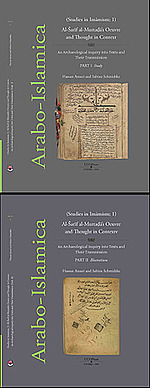
Al-Šarīf al-Murtaḍā's Oeuvre and Thought in Context: An Archaeological Inquiry into Texts and their Transmission, by Hassan Ansari and Sabine Schmidtke. This book is a detailed analysis of the reception and transmission of the doctrinal, legal, literary, and exegetical oeuvre of al-Šarīf al-Murtaḍā, arguably one of the most important thinkers of the medieval period, within and beyond Twelver Šīʿism. The study undertakes an archaeological inquiry of sorts into al-Murtaḍā’s monographic works and their transmission through an analysis of their manuscript tradition from al-Murtaḍā’s time until the contemporary period, covering the full range of the disciplines that he addressed. Inspired by similar quests undertaken by scholars of early modern Europe, this study also pays special attention to the various clusters of one-volume libraries of al-Murtaḍā's writings, the earliest witnesses of which can be traced back to the sixth/twelfth and seventh/thirteenth centuries, and it discusses their astoundingly linear transition from manuscript to print. The resulting insights into the transmission of al-Murtaḍā’s oeuvre allow for a careful reconstruction of the relative chronology of al-Murtaḍā’s works in the various disciplines, a necessary foundation for future in-depth analysis of the development of his theological, legal, and exegetical thought. Part I: Study; Part II Illustrations. See also:
https://albert.ias.edu/20.500.12111/6508. Additional information.
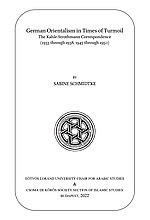
German Orientalism in Times of Turmoil: The Kahle-Strothmann Correspondence (1933 through 1938, 1945 through 1950) by Sabine Schmidtke. This study offers an annotated edition of the correspondence between Paul Ernst Kahle (1875–1964) and Rudolf Strothmann (1877–1960), two of the leading representatives of Oriental studies in Germany during the first half of the twentieth century. Kahle’s and Strothmann’s early epistolary exchange (1933–1938) falls into the period of Nazi rule in Germany, shedding some light on the ways in which each of them negotiated the political intricacies, temptations and dangers of the period. The situation completely changed for the two scholars during the second period of their correspondence, 1945 through 1950. Although Kahle thrived in his scholarly work during his time in England where he emigrated in 1938, he had lost his position of power within German academia. His letters show that he did not realize that his voice was no longer wanted or needed and that he was out of touch with the reality of post-war Germany. Strothmann in turn had gone through difficult years. Moreover, during 1946 and 1947 he fell seriously ill and was repeatedly hospitalized for several months, in addition to other common hardships during the immediate post-war period. Strothmann’s letters illustrate those dire circumstances while at the same time reflecting his determination to pursue his scholarship at all costs, and with success. Additional information.

Yemeni Manuscript Cultures in Peril, edited by Hassan Ansari & Sabine Schmidtke. The most significant and by far largest collections of Zaydi manuscripts are housed by the many public and private libraries of Yemen, an endangered cultural heritage tradition, currently at risk due to the conflict and warfare in Yemen. The contributions brought together in this volume address a wide spectrum of aspects concerning Yemeni manuscript cultures, with some focusing on their history and present state within Yemen and others discussing the collections of manuscripts of Yemeni provenance in Europe and elsewhere. Additional information.
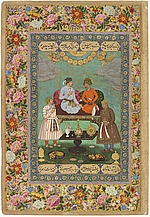
Safavid and Mughal Empires in Contact: Intellectual and Religious Exchanges between Iran and India in the Early Modern Era, Entangled Religions (Open Access, vol 13, no. 5), guest editors: Reza Pourjavady and Kianoosh Rezania. This special issue investigates the intellectual and religious contacts between Safavid Iran and Mughal India in the sixteenth and seventeenth centuries. Iran and North India witnessed fundamental cultural changes in the early modern period, which profoundly formed their new identity. The rulers of Iran at the time, the Safavids (1501–1722), proclaimed Shi’i Islam as the state religion; The Mughal emperors (1526–1858) fostered an environment in India where Islam, Hindu religions, Christianity and Zoroastrianism came more intensively in dialogue. Numerous syncretistic trends emerged from this entangled situation and the contacts affected the respective religions as well. The volume covers several individual studies on topics related to the migration of Safavid scholars to the Mughal empire and its religious and intellectual outcomes. Additional information.
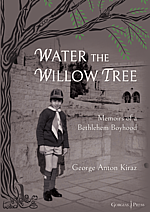
Water the Willow Tree: Memoirs of a Bethlehem Boyhood, by George Anton Kiraz. In this engaging first memoir, George A. Kiraz tells the story of a young Palestinian boy growing up in Bethlehem, fascinated with understanding his Syriac roots even as he drew steadily nearer to the day when he would inevitably be transplanted to the United States. Additional information.
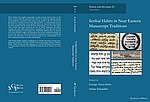
Scribal Habits in Near Eastern Manuscript Traditions, edited by George Anton Kiraz and Sabine Schmidtke. This volume brings together contributions by scholars focusing on peritextual elements as found in Middle Eastern manuscripts: dots and various other symbols that mark vowels, intonation, readings aids, and other textual markers; marginal notes and sigla that provide additional explanatory content akin to but substantially different from our modern notes and endnotes; images and illustrations that present additional material not found in the main text. These elements add additional layers to the main body of the text and are crucial for our understanding of the text’s transmission history as well as scribal habits. Additional information.
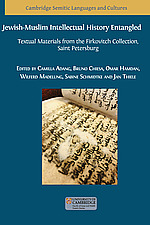
Jewish-Muslim Intellectual History Entangled: Textual Materials from the Firkovitch Collection, Saint Petersburg. Camilla Adang, Bruno Chiesa, Omar Hamdan, Wilferd Madelung, Sabine Schmidtke and Jan Thiele (eds). This book unearths forgotten texts that once belonged to the library of the Karaite community in Cairo. Consigned to oblivion for centuries, many of these manuscripts were sold in the second half of the nineteenth century to the National Library of Russia in St Petersburg, where they remained inaccessible to most scholars until the end of the Cold War. Additional information.

The Syriac Orthodox in North America (1895-1995): A short History, by George Anton Kiraz. A short history of the Syriac Orthodox community in North America between 1895, the year of the First Sayfo that triggered the first wave of immigration to North America, and 1995, marking the passing away of Metropolitan Mor Athanasius Yeshue Samuel, the first and only Archbishop of the Syriac Orthodox Archdiocese of the United States and Canada. Additional information.
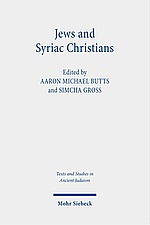
Jews and Syriac Christians: Intersections across the First Millennium, edited by Aaron Michael Butts and Simcha Gross. Scholarly interest in intersections between Jews and Syriac Christians has experienced a boom in recent years. This is the result of a series of converging trends in the study of both groups and their cultural productions. The present volume contributes to this developing conversation by collecting sixteen studies that investigate a wide range of topics, from questions of origins to the development of communal boundaries, from social interactions to shared historical conditions, involving Jews and Syriac Christians over the first millennium CE. Additional information.
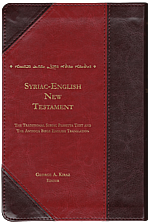
Syriac-English New Testament, general editor George Anton Kiraz; translated by Jeff W. Childers, J. Edward Walters, Daniel King, Robert A. Kitchen, Jerome Alan Lund and James Prather. After the success of the Antioch Bible, this publication is a new, historic edition of the Syriac-English New Testament in a single volume. The English translations of the New Testament Syriac Peshitta along with the Syriac text were carried out by an international team of scholars. Additional information.
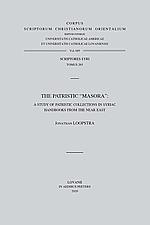
The Patristic ‘Masora’. A Study of Patristic Reading Traditions in the Near East by Jonathan Loopstra. This volume is the first-ever study and transcription of over ten thousand excerpted ‘vocalized words and readings’ (šmohē w-qroyoto) from works attributed to Greek writers such as Ps.-Dionysius, Basil, Gregory of Nazianzus, and Severus of Antioch. This material has the potential to inform not only Syriac studies and Patristics, but the broader study of literacy and modes of learning in the Medieval Middle East. Additional information.
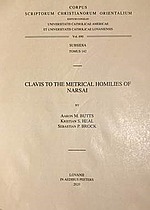
Clavis to the Metrical Homilies of Narsai, by Aaron M. Butts, Kristian S. Heal, and Sebastian P. Brock. Narsai (d. ca. 500), who is variously called “the tongue of the East” and “the harp of the Spirit,” is the most foundational East Syriac theologian and exegete and among the most important and influential Syriac authors more broadly. Just over eighty metrical homilies (mēmrē)attributed to Narsai survive. The present volume serves as a clavis to Narsai’s homilies. The volume also contains a curated bibliography that provides a sense of the history of scholarship on Narsai. Additional information.

Syriac Christian Culture: Beginnings to Renaissance, edited by Aaron Michael Butts and Robin Darling Young. Syriac Christianity developed in the first centuries CE in the Middle East, where it continued to flourish throughout Late Antiquity and the Medieval period, while also spreading widely, as far as India and China. Today, Syriac Christians are found in the Middle East, in India, as well in diasporas scattered across the globe. Over this extended time period and across this vast geographic expanse, Syriac Christians have built impressive churches and monasteries, crafted fine pieces of art, and written and transmitted a sizable body of literature. The present volume brings together fourteen studies that offer fresh perspectives on Syriac Christianity, especially its literary texts and authors. Reflecting a growing trend in the field, the volume also devotes significant attention to the Medieval period, during which Syriac Christians lived under Islamic rule. The studies in the volume are united in their quest to explore the richness, diversity, and vibrance of Syriac Christianity. Additional information.
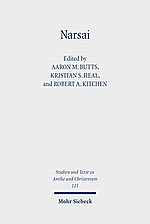
Narsai: Rethinking his Work and his World, edited by Aaron M. Butts, Kristian S. Heal and Robert A. Kitchen. Narsai († ca. 500) was a founding theologian of the Church of the East. Active first at the School of the Persians in Edessa and later at the School of Nisibis, Narsai creatively synthesized his native Syriac tradition with the newly translated works of Antiochene theology and exegesis. In a time of theological upheaval, his works helped forge a new theological tradition in Syriac. This groundbreaking collection of original essays refocuses attention on this fascinating Late Antique thinker and illustrates his importance for understanding Christianity in Late Antiquity. The essays highlight Narsai’s contributions to exegesis, asceticism and moral formation, Jewish-Christian relations, liturgical theology, and place his work and thought within the cultural and intellectual world of two leading Christian centers in the Roman-Persian frontiers in the fifth century. Additional information.
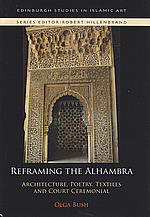
Reframing the Alhambra: Architecture, Poetry, Textiles and Court Ceremonial, by Olga Bush (hardcover, Edinburgh University Press, 2018). UPCOMING paperback, Edinburgh University Press, October 2020. An interdisciplinary study of one of the most important monuments in Islamic art. Finalist for the 2019 Charles Rufus Morey Book Award. Honorable mention for the 2019Eleanor Tufts Book Award, American Society for Hispanic Art Historical Studies. Additional information.
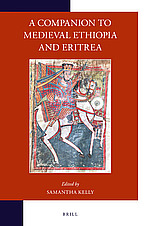
A Companion to Medieval Ethiopia and Eritrea, Samantha Kelly, editor. Introduces readers to current research on major topics in the history and cultures of the Ethiopian-Eritrean region from the seventh century to the mid-sixteenth, with insights into foundational late-antique developments where appropriate. Additional information.

The Discourses: Reflections on History, Sufism, Theology, and Literature-Volumen One. By Abu 'Ali al-Hasan al-Yusi and edited and translated by Justin Stearns. Wide-ranging essays on Moroccan history, Sufism, and religious life. Translated into English for the first time, The Discourses offers readers access to the intellectual landscape of the early modern Muslim world through an author who speaks openly and frankly about his personal life and his relationships with his country’s rulers, scholars, and commoners. Additional information.
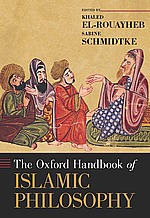
Paperback edition of The Oxford Handbook of Islamic Philosophy. Explores the uninterrupted history of Islamic philosophy down to the modern period. Edited by Khaled El-Rouayheb, Harvard University, and Sabine Schmidtke, Institute for Advanced Study. Additional information.

The Zaydi Reception of Bahshamite Muʿtazilism. Fascimile Edition of MS Shiraz, Library of the Faculty of Medicine at the University of Shiraz (ʿAllāma Ṭabāṭabāʾī Library), majmūʿa 102. Prepared for publication and Introduced by Hassan Ansari and Sabine Schmidtke, Piscataway, NJ: Gorgias Press, 2019. Among the few Muʿtazilite Zaydi works preserved in the libraries of Iran is a miscellany held by the library of the Faculty of Medicine at the University of Shiraz (ʿAllāma Ṭabāṭabāʾī Library). The maǧmūʿa, a facsimile of which is included in the present publication, was written between 673/1274-75 and 676/1277 and contains doctrinal works by Imāmi and Zaydi theologians from both Iran and from Yemen. Additional Information.

Muslim Perceptions and Receptions of the Bible: Texts and Studies, Camilla Adang and Sabine Schmidtke, Atlanta, GA, Lockwood Press. The articles brought together in this volume deal with Muslim perceptions and uses of the Bible in its wider sense, including the Hebrew Bible or Old Testament as well as the New Testament, albeit with an emphasis on the former scripture. Additional information.
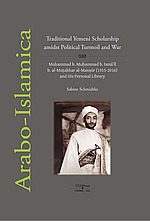
Traditional Yemeni Scholarship amidst Political Turmoil and War: Muḥammad b. Muḥammad b. Ismāʿīl b. al-Muṭahhar al-Manṣūr (1915-2016) and His Personal Library, Sabine Schmidtke, Cordoba: UCOPress, 2018 (Series Arabo-Islamica; 1). The volume evolved as a side product of the "Zaydi Manuscript Tradition" (ZMT) project, a collaborative undertaking by the Institute for Advanced Study (IAS), Princeton, in partnership with the Hill Museum & Manuscript Library (HMML) at Saint John’s University, Collegeville, Minnesota, which aims at bringing together the widely dispersed Zaydī manuscript culture in its entirety in a single repository. It focusses on Muḥammad b. Muḥammad b. Ismāʿīl al-Manṣūr (1915-2016), one of the most prominent scholars, bureaucrats, and politicians of twentieth-century Yemen, and his private collection of manuscripts. Based on his ijāza ("licence to transmit"), his own writings, and other documentary materials, as well as his collection of manuscripts and the many handwritten comments and notes added by al-Manṣūr, the book discusses his biography and intellectual milieu and provides insights into the manuscript culture of twentieth-century Yemen. Taken together, the volume contributes to the study of twentieth-century Yemen's intellectual and social history, and it immediately relates to recent work of historical anthropologists specializing in Yemen. Additional Information.
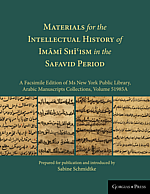
Materials for the Intellectual History of Imāmī Shīʿism in the Safavid Period. A Facsimile Edition of Ms New York Public Library, Arabic Manuscripts Collections, Volume 51985A. Prepared for publication and introduced by Sabine Schmidtke, Institute for Advanced Study, Princeton (Piscataway, NJ: Gorgias Press, 2018). Additional information.

Paperback edition of The Oxford Handbook of Islamic Theology. Edited by Sabine Schmidtke, Institute for Advanced Study, Princeton. Additional information.
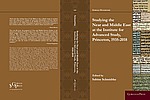
Studying the Near and Middle East at the Institute for Advanced Study, Princeton, 1935-2018. Edited by Sabine Schmidtke, Institute for Advanced Study, Princeton (Piscataway, NJ: Gorgias Press, 2018). Additional information.
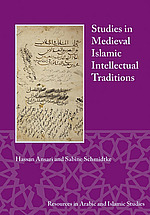
Studies in Medieval Islamic Intellectual Traditions. Hassan Ansari and Sabine Schmidtke, Atlanta, GA, Lockwood Press. Additional information. Also in JSTOR.
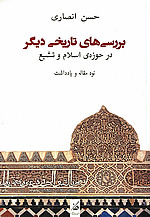
Hassan Ansari, Barrassī-hā-yi tārīkhi-yi dīgar dar ḥawza-yi Islām wa tashayyuʿ, Isfahan: Intishārāt-i Dahgān, 1396/2017
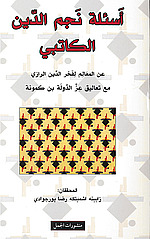
Asʾilat Najm al-Dīn al-Kātibī ʿan al-Maʿālim li-Fakhr al-Dīn al-Rāzī maʿa taʿālīq ʿIzz al-Dawla b. Kammūna [Critical Remarks by Najm al-Dīn al-Kātibī on the Kitāb al-Maʿālim by Fakhr al-Dīn al-Rāzī, together with the Commentaries by ʿIzz al-Dawla Ibn Kammūna], ed. Reza Pourjavady & Sabine Schmidtke, Beirut/Baghdad: Manshūrāt al-Jamal, 2016.

Miyān-e kalām wa falsafa wa chand pajūhesh-e dīgar darbāre-ye tārīkh wa adabiyyāt-e kalāmī-e muʿtazelīyān, Tehran, Nashr-e kitāb-e rāyzan, 2016. Hassan Ansari, Institute for Advanced Study, Princeton.
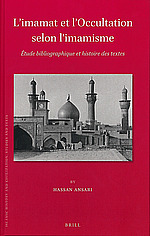
L'imamat et l'Occultation selon l'imamisme. Étude bibliographique et historie des textes. Hassan Ansari, Institute for Advanced Study, Princeton. Additional information

The Oxford Handbook of Islamic Philosophy (hardcover). Explores the uninterrupted history of Islamic philosophy down to the modern period. Edited by Khaled El-Rouayheb, Harvard University, and Sabine Schmidtke, Institute for Advanced Study. Additional information.
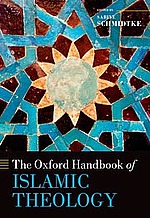
The Oxford Handbook of Islamic Theology. Provides a comprehensive and authoritative survey of the latest scholarship on the development of Islamic Theology. Edited by Sabine Schmidtke, Institute for Advanced Study, Princeton. Additional information.

Al-Ṣāḥib Ibn ʿAbbād Promoter of Rational Theology. Two Muʿtazilī kalām texts from the Cairo Geniza. Wilferd Madelung, University of Oxford, and Sabine Schmidtke, Institute for Advanced Study. Additional information.
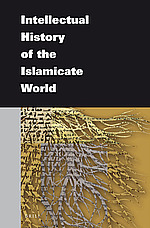
Special Issue: Histories of Books in the Islamicate World. Part II (Volume 5, Issue 1-2). Ed. Maribel Fierro, Sabine Schmidtke, Sarah Stroumsa = Intellectual History of the Islamicate World 5 (2017) [Leiden: Brill].

Al-Mutabaqqā min kutub mafqūda, vol. 1, Daftar-i tablīghāti islāmī, Shuʿba-yi ustān-i Isfahān, Isfahān, 1395/2016. Hassan Ansari, Institute for Advanced Study, Princeton.
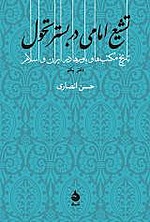
Tārīkh-e maktab-hā wa bāwar-hā dar irān wa islām [The History of Schools and Trends in Iran and Islam], vol. 1: The Formation and Development of the Imami Shi'i Tradition, Tehran, Našr-e māhī 2016. Hassan Ansari, Institute for Advanced Study, Princeton.
Az ganjīna-hā-yi nusakh-i khattī: Muʿarrifī-yi dast-niwishta-hā yī nafīs az kitābkhāna-hā-yi buzurg-i jahān dar Ḥawza-yi ʿulūm-i islāmī, vol. 1, Daftar-i tablīghāti islāmī, Shuʿba-yi ustān-i Isfahān, Isfahān, 1394/2015. Hassan Ansari, Institute for Advanced Study, Princeton.

Patricia Crone's Collected Studies in Three Volumes
The Qurʾānic Pagans and Related Matters. Volume 1; The Iranian Reception of Islam: The Non-Traditionalist Strands. Volume 2; Islam, the Ancient Near East and Varieties of Godlessness. Volume 3.
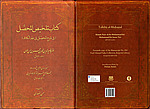
Talkhīṣ al-Muḥaṣṣal Khwājah Naṣīr al-Dīn Muḥammad b. Muḥammad b. Ḥasan Ṭūsī. Introductory Essay by Hassan Ansari. Facsimile copy of the Manuscript No. 834 Fazil Ahmad Pasha Collection, Koprulu Library (Copied in 669 A.H.). Tehran 2015.
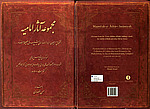
Majmūʿa-yi Āthār-i Imāmiyah (Extracts from the ʿUyūn Akhbār al-Riḍā, Ṣaddūq's Amālī, the Ṣaḥīfat al-Riḍā and other Shīʿite Texts). Introductory Essay by Hassan Ansari. Facsimile Edition of Manuscript No. 218 from the Collection of Codices that were Donated to the Majlis Library by Sayyid Muḥammad Ṣādiq Ṭabāṭabāʾī (copied in 580AH/1184AD). Tehran 2015.
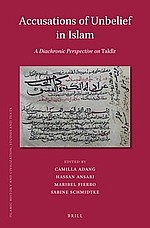
Accusations of Unbelief in Islam. A Diachronic Perspective on Takfir. Edited by Camilla Adang, Tel Aviv University, Hassan Ansari, Institute for Advanced Study, Princeton, Maribel Fierro, Consejo Superior de Investigaciones Científicas, and Sabine Schmidtke, Institute for Advanced Study, Princeton. Additional information.

The Yemeni Manuscript Tradition. Edited by David Hollenberg, University of Oregon, Christoph Rauch, Staatsbibliothek zu Berlin, and Sabine Schmidtke, Institute for Advanced Study, Princeton. Additional information.

Faylusūf-i yahūdī-yi Baghdād: Ibn Kammūna wa āthār-i u. Reza Pourjavady and Sabine Schmidtke: Faylusūf-i yahūdī-yi Baghdād: Ibn Kammūna wa āthār-i u, trans. Jawad Qasemi, revised by Hamid Ataei Nazari, Isfahan: Daftar-i tablīghāt-i islāmi: Shuʿba-yi ustān-i Iṣfahān, 2016 (Majmūʿa-yi muṭālaʿāt-i īrānī-islāmī; 2). Being a Persian translation of A Jewish Philosopher of Baghdad. ʿIzz al-Dawla Ibn Kammūna (d. 683/1284) and His Writings, Leiden: Brill, 2006 (Islamic Philosophy, Theology and Science; 65).
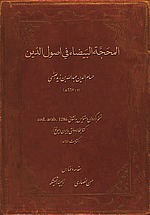
Zaydī theology in 7th/13th century Yemen. Zaydī theology in 7th/13th century Yemen: Facsimile edition of Kitāb al-Maḥaǧǧa al-bayḍā fī uṣūl al-dīn of ʿAbd Allāh b. Zayd al-ʿAnsī (d. 667/1269) (MS Munich, Bayerische Staatsbibliothek, Cod. arab. 1286). Introduction and Indices by Hassan Ansari and Sabine Schmidtke. Tehran: Mīrāth-i maktūb, 2016 (Classical Muslim Heritage Series; 9).